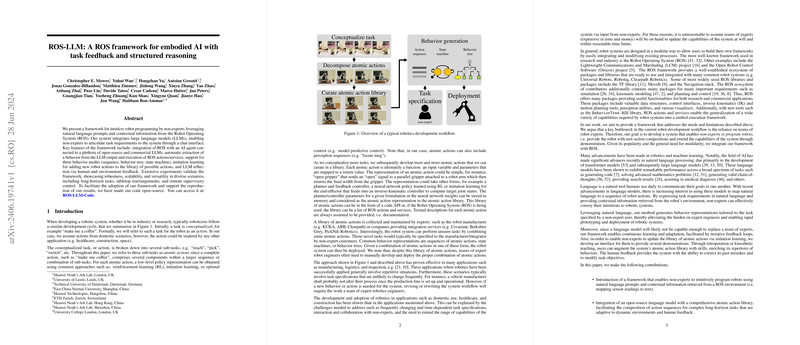Overview of "ROS-LLM: A ROS framework for embodied AI with task feedback and structured reasoning"
The paper "ROS-LLM: A ROS framework for embodied AI with task feedback and structured reasoning" introduces a novel approach for robot programming designed to facilitate interaction by non-experts through natural language prompts. This research integrates the Robot Operating System (ROS) with LLMs, providing a framework that enables users to communicate complex tasks to robots using a chat interface. This integration addresses the limitations of requiring expert involvement for reprogramming robotic tasks and extends the capabilities of robotic systems through human feedback and imitation learning.
Key Contributions
The paper details several key contributions:
- Integration of ROS with LLMs: The authors introduce a framework that siphons the capabilities of LLMs into the ROS ecosystem. This allows non-expert users to describe tasks in natural language, which the system then interprets and converts into executable robotic actions.
- Behavior Representation: The framework supports three behavior representation modes: sequences, behavior trees, and state machines. The atomic actions in these behaviors can be augmented via human demonstrations, expanding the robot's skill set.
- Imitation Learning: Non-experts can enhance the robot's library of actions by providing demonstrations through teleoperation or kinesthetic teaching, which are then translated into executable robotic commands using DMPs.
- Feedback Integration: The system allows for continuous improvement via human and environmental feedback, providing a mechanism for robots to correct past mistakes and update task objectives iteratively.
- Comprehensive Validation: The authors present extensive real-world experiments validating the framework's robustness, scalability, and versatility through diverse scenarios, including long-horizon tasks and remote supervisory control.
Experimental Validation
The experimental section of the paper is thorough, detailing a variety of scenarios to test the framework. Notably:
- Long-Horizon Tasks: The system successfully executed a complex multistep task—making coffee—demonstrating the system's capability to plan and execute sequences of actions based on a high-level natural language prompt.
- Policy Correction via Human Feedback: The research highlights the importance of human feedback in correcting the system's policy errors. As task complexity increased, the incorporation of human feedback maintained task success rates, thus demonstrating the practicality of continuous learning.
- Imitation Learning for Action Library Update: The framework was adept at learning new tasks such as stirring and pouring via human demonstrations, validating its capability for continual learning and adaptability.
- Adapting to Changing Environments: The system demonstrated resilience by adapting to dynamic environmental changes using feedback to autonomously adjust actions in subsequent trials.
- Remote Supervisory Control: Experiments with remote operators controlling the robot across continents showcased the framework's applicability for tasks that necessitate remote operations, emphasizing the global potential of such a system.
Implications and Future Directions
The implications of this research are considerable for both practical applications and theoretical advancements in robotics and AI. Practically, the framework can significantly reduce the dependency on expert robotic engineers by empowering non-experts to intuitively interact with and program robots. This can revolutionize industries where task specifications are frequently changing and require rapid updates, such as healthcare, domestic robotics, and remote inspections.
Theoretically, this framework poses new questions and challenges for future developments in AI and robotics. The inclusion of fine-tuning LLMs specifically for robotics tasks, enhancing reward shaping mechanisms, and integrating multimodal input forms are potential areas for advancement. The ongoing development of more sophisticated feedback systems, rewarding structures, and multi-task learning capabilities could further push the boundaries of what such systems can achieve.
Additionally, expanding the framework's compatibility to support ROS 2 and more diverse robotic platforms like quadrupeds would likely broaden its application scope. The robustness of behavior trees and state machines in real-world settings presents another avenue for refining the framework.
Conclusion
The "ROS-LLM" framework represents a substantial step forward in the field of intuitive and accessible robot programming for non-expert users. Integrating LLMs with ROS while enabling nuanced feedback mechanisms and imitation learning creates a system with both practical utility and significant theoretical interest. The extensive validation through real-world experiments underscores its potential impact across various industries, setting the stage for further advancements and broader adoption in embodied AI. The paper articulates a clear pathway for how continuous learning and user-friendly interfaces can redefine human-robot interaction, emphasizing adaptability and resilience in dynamic environments.
